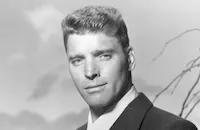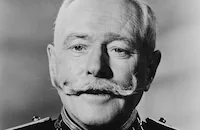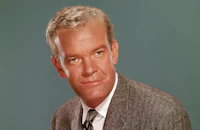Seven Days in May

Brief Synopsis
Cast & Crew
John Frankenheimer
Burt Lancaster
Kirk Douglas
Fredric March
Ava Gardner
Edmond O'brien
Film Details
Technical Specs

Synopsis
U. S. President Jordan Lyman signs a nuclear treaty with the Soviet Union, arousing public displeasure and the disapproval of the military, particularly Gen. James M. Scott, Chairman of the Joint Chiefs of Staff, who considers the action almost treasonable. After Martin "Jiggs" Casey, Scott's aide, comes across some cryptic messages and learns of a top secret base in Texas, the existence of which is denied by others in the Pentagon, he suspects that Scott is leading the other Chiefs of Staff in a coup to occur seven days later when the President will be isolated from his civilian aides during a military alert. Casey reports his suspicions to the President, who sends Sen. Raymond Clark to investigate the secret base. Clark locates the base but is held there incommunicado until he breaks out with the help of an officer friend of Casey's. Presidential aide Paul Girard flies to Gibraltar, where he obtains a statement from Admiral Barnswell, a Joint Chief who isn't enthusiastic about the coup, but Girard is killed in a plane crash on the return trip, and Barnswell denies signing the statement. Later, Casey obtains some highly incriminating letters from Eleanor Holbrook, Scott's former mistress, but the President cannot bring himself to use them when he confronts Scott and demands his resignation. Scott, confident that public opinion is on his side and that his aides are behind him, refuses. The President goes on television to demand the guilty officers' resignations, and Scott's colleagues desert him. During the telecast it is learned that Barnswell's statement has been found in the plane wreckage, and Scott also resigns, squelching the coup before it occurs.

Director

John Frankenheimer
Cast

Burt Lancaster

Kirk Douglas

Fredric March

Ava Gardner

Edmond O'brien

Martin Balsam

George Macready

Whit Bissell

Hugh Marlowe
Bart Burns

Richard Anderson

Jack Mullaney

Andrew Duggan
John Larkin
Malcolm Atterbury
Helen Kleeb
John Houseman
Colette Jackson
Fredd Wayne
Rodolfo Hoyos
Clegg Hoyt
Crew
Angela Alexander
Darryl Anderson
Robert J. Anderson
Vaughan Asher
Dick Borland
Edward G. Boyle
Bill Brame
Ross Burke
Thom Conroy
R. D. Cook
Joe Edmondson
John Franco
John Frankenheimer
Ellsworth Fredricks
Charles Gay
Jerry Goldsmith
Dale Hutchinson
Phil Jeffries
Wes Jeffries
Art Jones
Edward Lewis
William Maldonado
Kyme Meade
John Mehl
Sid Mintz
Cary Odell
Hal Polaire
Hal Polaire
Rod Serling
Maggie, Sec Smith
Sterling Smith
W. C. Smith
Ferris Webster
Paul Weddell

Photo Collections
Videos
Movie Clip





Trailer
Hosted Intro




Film Details
Technical Specs

Award Nominations
Best Art Direction
Best Supporting Actor
Articles
Seven Days in May
The Knebel-Bailey novel was purchased for the screen through the joint efforts of Frankenheimer and Kirk Douglas, who agreed to produce and star in the film. However, the director almost backed out of the project when he learned that Douglas was intent on casting Burt Lancaster in the film. Frankenheimer had previously worked with Lancaster on Birdman of Alcatraz (1962) and found it to be a frustrating, demoralizing experience. During one heated argument over camera placement, the actor had picked Frankenheimer up off the ground, carried him across the room, and plunked him down, stating emphatically, "That's where the camera goes." Yet, despite major reservations about working with Lancaster again, Frankenheimer was assured by Douglas that there would be no problems on the set; Douglas even agreed to offer Lancaster his choice of roles, a generous gesture he would later regret.
Seven Days in May was shot on location in California, Arizona and selected areas in and around the District of Columbia. President Kennedy was particularly interested in seeing a movie version of the book and, thanks to his support, Frankenheimer was able to secure permission to film a riot sequence in front of the White House. But the filmmakers knew it was futile to ask any Pentagon officials if they could shoot any sequences at their headquarters; they returned to Paramount Studios to film those, except for one scene which was filmed without the Pentagon's knowledge. In Gerald Pratley's book, The Cinema of John Frankenheimer, the director said, "We had the camera in the back of a station wagon with a black cloth over it. Kirk...changed into his Marine Colonel's outfit. He...drove up and parked his car, got out and walked into the Pentagon. Three men saluted him. Three other officers saluted him. They really thought he was a colonel. He walked into the Pentagon. We had two cameras, each with a different lens. He turned right around, walked out, and got back into his car and drove off. This gave us entrance and exit shots. We were gone in about five minutes."
As Douglas had promised, Lancaster didn't create any problems for Frankenheimer during production on Seven Days in May. However, Ava Gardner was another story; she would call the director into her dressing room daily after several drinks to complain about the production, her part, or his favoritism toward other cast members. (She even accused the director of having a homosexual relationship with Kirk Douglas due to their numerous private meetings!) At the same time, some of the actors found Frankenheimer's directing style a little odd. Martin Balsam, in particular, was annoyed at Frankenheimer's habit of firing pistol shots close behind him during critical moments.
In John Frankenheimer: A Conversation with Charles Champlin, the director recalled his experience on Seven Days in May: "We rehearsed for two weeks and shot it in fifty days. The only big problem was that, just as I'd warned him, Douglas realized more and more that the colonel was a lousy part, much inferior to Burt's. One day in his dressing room in his undershorts he launched a tirade at me, including the fact that I did not seem to know a major star when I saw one....On the other hand, Lancaster and I became close friends during the making of Seven Days in May....I think one of the best scenes I ever directed was between Burt and Fredric March in the president's Oval Office, when Lancaster is telling him he has to resign, and March won't....I don't think I ever directed anyone who had the same kind of presence on the screen - and off the screen - as Burt."
As for Kirk Douglas, he certainly had a few things to say about Frankenheimer in his own autobiography, The Ragman's Son: "It's ironic. I arrange this rapprochement between Frankenheimer and Burt, and then the two of them go off, great buddies. In interviews later, Frankenheimer played the role of the great auteur - and I was just some actor working under his tutelage, grateful for his guidance. He twisted the whole thing around."
In his autobiography, Douglas also provided a little-known detail about Seven Days in May. "We also shot an ending that I liked very much, but which we didn't use. General Scott, the treacherous Burt Lancaster character, goes off in his sports car, and dies in a wreck. Was it an accident or suicide? Coming up out of the wreckage over the car radio is President Lyman Jordan's speech about the sanctity of the Constitution. Instead, the last time we see Burt is in his confrontation with me. He regards me as a traitor to him; I know he has been a traitor to the country. He says to me, "Do you know who Judas was?" I answer, "Yes. He's a man I used to work for and respect, until he disgraced the three stars on his uniform."
When Seven Days in May opened theatrically, it fared well with critics and audiences alike. The New York Times reported that it was "taut and exciting melodrama, as loaded as a Hitchcock mystery" and the film also picked up two Academy Award nominations; one for Best Supporting Actor (Edmond O'Brien's colorful turn as a southern senator fond of booze) and one for Best Art and Set Decoration.
Producer: Kirk Douglas, Edward Lewis
Director: John Frankenheimer
Screenplay: Rod Serling
Production Design: Cary Odell
Cinematography: Ellsworth Fredericks
Costume Design: Wes Jeffries
Film Editing: Ferris Webster
Original Music: Jerry Goldsmith
Cast: Burt Lancaster (Gen. James M. Scott), Kirk Douglas (Col. Martin "Jiggs" Casey), Fredric March (President Jordan Lyman), Ava Gardner (Eleanor Holbrook), Edmond O'Brien (Senator Raymond Clark), Martin Balsam (Paul Gerard), Andrew Duggan (Col. William "Mutt" Henderson), Hugh Marlowe (Harold McPherson), Whit Bissell (Senator Frederick Prentice), George Macready (Christopher Todd).
BW-118m. Letterboxed.
by Jeff Stafford

Seven Days in May
Quotes
That could easily mean another place. These military games... why, the multiplicity of our secret bases confuses ourselves more than the Soviets.- Christopher Todd
Do you rent space in that thing?- Senator Raymond Clark
You make me think that fruit salad on your chest is for neutrality, evasiveness, and fence-straddling.- Senator Frederick Prentice
On the contrary, Senator, they're standard awards for cocktail courage and dinner-table heroism. I thought you'd invented them.- Colonel Martin 'Jiggs' Casey
We seem to spend more time training for seizure than for prevention, like the Commies already had the stuff, and we had to get it back.- Colonel William 'Mutt' Henderson
I'll make you two promises: a very good steak, medium rare, and the truth, which is very rare.- Eleanor 'Ellie' Holbrook
Trivia
The Pentagon forbids camera crews near the entrances to the complex, due to security reasons. Still, Director John Frankenheimer wanted a shot of Kirk Douglas' character entering the building. So, they rigged up a station wagon with a camera to film Douglas, in a full Marine colonel's uniform walking up the steps of the Pentagon. The salutes Douglas received in that scene were real as the guards had no reason to believe it was for a movie!
Notes
Location scenes filmed in Washington, D. C., and in Arizona.

Miscellaneous Notes
Released in United States Winter January 1, 1964
Released in United States 1995
Released in United States 1996
Director John Frankenheimer died July 6, 2002 of a stroke at the age of 72.
Feature acting debut for producer John Houseman.
Released in United States Winter January 1, 1964
Released in United States 1995 (Shown at AFI/Los Angeles International Film Festival (The AFI Fest Movie Marathon All Night: Left Wing versus Right Wing) October 19 - November 2, 1995.)
Released in United States 1996 (Shown in New York City (MOMA) as part of program "Directed by John Frankenheimer: The Television and Film Work" January 19 - February 6, 1996.)














